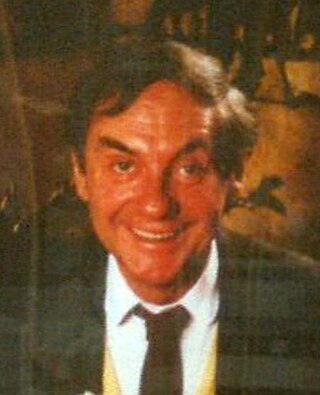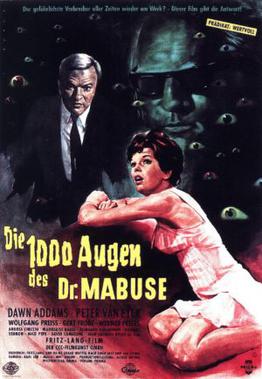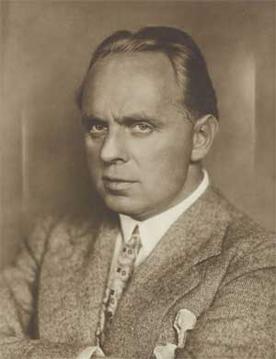
Dr. Mabuse is a fictional character created by Norbert Jacques in his 1921 novel Dr. Mabuse, der Spieler, and his 1932 follow-up novel Das Testament des Dr. Mabuse (1932). The character was made famous by three films about the character directed in Germany by Fritz Lang: Dr. Mabuse the Gambler, The Testament of Dr. Mabuse (1933), and the much later The Thousand Eyes of Dr. Mabuse (1960). Five other films featuring Dr. Mabuse were made by other directors in Germany in the early 1960s, followed by Jess Franco's interpretation The Vengeance of Dr. Mabuse in 1971.

Harald Juhnke, was a German actor, comedian, and singer.

The Thousand Eyes of Dr. Mabuse is a 1960 black-and-white crime thriller film directed by Fritz Lang in his final film. A West German/French/Italian international co-production, it starred Peter van Eyck, Dawn Addams and Gert Fröbe. The film made use of the character Dr. Mabuse, who had appeared in earlier films by Lang in 1922 and 1933. The Thousand Eyes of Dr. Mabuse spawned a film series of German Mabuse films that were released over the following years to compete with Rialto Film's Krimi films.

Nadja Tiller was an Austrian actress in film, television, and on stage. She was one of the most popular German-speaking actresses in the international cinema of the 1950s and 1960s, receiving international recognition when she played the title role in the 1958 film Das Mädchen Rosemarie (Rosemary) in 1958, shown at the Venice Film Festival. It opened the way to international films. She often played alongside her husband, Walter Giller.

Carl de Vogt was a German film actor who starred in four of Fritz Lang's early films. He attended the acting school in Cologne, Germany. Together with acting he was also active as a singer and recorded several discs. His greatest hit was "Der Fremdenlegionär". An extremely successful actor in his early career, he died in relative obscurity in 1970.

Friedrich Rudolf Klein, better known as Rudolf Klein-Rogge, was a German film actor, best known for playing sinister figures in films in the 1920s and 1930s as well as being a mainstay in director Fritz Lang's Weimar-era films. He is probably best known in popular culture, particularly to English-speaking audiences, for playing the archetypal mad scientist role of C. A. Rotwang in Lang's Metropolis and as the criminal genius Doctor Mabuse. Klein-Rogge also appeared in several important French films in the late 1920s and early 1930s.

Theo Lingen, born Franz Theodor Schmitz, was a German actor, film director and screenwriter. He appeared in more than 230 films between 1929 and 1978, and directed 21 films between 1936 and 1960.
Robert Adolf Stemmle was a German screenwriter and film director. He wrote for more than 80 films between 1932 and 1967. He also directed 46 films between 1934 and 1970. His 1959 film Die unvollkommene Ehe was entered into the 1st Moscow International Film Festival. He was born in Magdeburg, Germany and died in Baden-Baden, West Germany.
Rudolf Ernst Paul Schündler was a German actor and director. He played "Karl" in The Exorcist (1973).
Hans Heinz Zerlett was a German screenwriter and film director.

Wolfgang Neuss was a German actor and Kabarett artist. Wolfgang Neuss and Wolfgang Müller (1922–1960) were a popular double act. Beginning in the mid-1960s, Neuss also became famous for his political engagement, first for the SPD, then for the extra-parliamentary opposition, APO. He died in 1989 from a longtime cancer.

Lien Deyers was a Dutch actress based in Germany.

Franz R. Friedl, was an Austrian violist, composer and film composer. The son of a cooper he attended grammar school and then received artistic training from Rosé and Carl Flesch. Friedl then worked as concertmaster in Dortmund and Dresden. From 1923 to 1926 Franz Friedl was principal violist at the Teatro Colón in Buenos Aires, since 1927 the Upper Austrian, worked as a composer and composed chamber music, overtures. From 1933 he was music composer for theatre and films. He is listed on some recordings as the conductor of the "Berlin Symphony Orchestra", a pseudonym of an unidentified ensemble, but it is doubtful whether he actually was the conductor. From 1940-1945 he was musical director of Die Deutsche Wochenschau. The grandchild of his only daughter is Björn Stenvers.
Marlene Morreis (born 21 December 1976 in Schärding, Upper Austria, is an Austrian actress.










